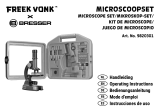Page is loading ...

77
GB
RISK to your child!
Aids with sharp edges and tips are so-
metimes used with this device. Please
store the device and all of its accessories and
aids out of the reach of children. There is a
risk of INJURY.
Children should only use this device under
supervision. Keep packaging materials (plas-
tic bags, rubber bands, etc.) away from child-
ren. There is a risk of SUFFOCATION.
The chemicals and liquids provided should
be kept out of reach of children. Do not drink
the chemicals! Hands should be washed tho-
roughly under running water after use. In case
of accidental contact with the eyes or mouth
rinse with water. Seek medical treatment for
ailments arising from contact with the chemi-
cal substances and take the chemicals with
you to the doctor.
Fire/Burning RISK!
Never subject the device - especially
the lenses - to direct sunlight. Light
ray concentration can cause fires and/or
burns.
TIPS on cleaning
Clean the lens (objective and eye-
piece) only with the cloth supplied or
some other soft lint-free cloth (e.g.
micro-fibre). Do not use excessive pressure -
this may scratch the lens.
Dampen the cleaning cloth with a spectacle
cleaning fluid and use it on very dirty lenses.
DISPOSAL
Dispose of the packaging material/s
as legally required. Consult the local
authority on the matter if necessary.
Your experiment set is made up of the
following components:
1 Shrimp eggs
2 Sea salt
3 Yeast
4 Gum media
5 Prepared slide “Fabric” (material)
6 Prepared slide “Shrimp”
7 Prepared slide “Honeybee”
8-12 Empty vials
13 Prepared slide “Butterfly Wings”
14 Cover slips
15 Adhesive labels
16 Shrimp hatchery
17 Slide
18 Pipette
19 Tweezers
20 Dissecting needle
21 Scalpel
22 Magnifying glass
What you need to know
Caution!
When using your experiment set,
wear an apron (or old clothing) and
rubber gloves!
Always carry out your experiments under the
guidance and with the help of an adult!
Your experiment set includes numerous ac-
cessories that help you carry out different ex-
periments. You can use all the parts indepen-
dently of the microscope that you use for your
research. Use the following web link to find
interesting experiments you can try out.
http://www.bresser.de/c/de/downloads
You can do them with the individual parts
of your experiment set.
Shrimp eggs
These are special eggs that are capable of
survival even when they are dried out. As a re-
sult, they are particularly ideal for raising brine
shrimp. You can find out how in the appendix
to these instructions.
Sea salt
You can observe the sea salt using your mi-
croscope. Salt is a crystal that looks very in-
teresting through a microscope. Apart from
that, you will also need the sea salt to make a

8
salt solution, in which you will hatch your brine
shrimp.
Yeast
The yeast in your experiment set is included as
feed for the brine shrimp. If you feed them regu
-
larly, you will be able to watch how they grow.
Gum media
This material is a glue that you can use to
make permanent prepared specimens.
Prepared slides „Honeybee,” “Fabric“
(material), “Shrimp” and “Butterfly
Wings”
Different prepared slides that you can investi-
gate using your microscope.
Empty vials
You can keep a few samples in the empty vials
(e.g. leaves, and, etc.)
Cover slips
You use the cover slips to cover specimens
that you have placed on a slide in order to ob-
serve with a microscope.
Adhesive labels
You can use these labels to identify your per-
manent prepared specimens. You can also
use them to label the empty vials.
Shrimp hatchery
You can hatch shrimp in the different cham-
bers and observe the different stages of de-
velopment.
Slides
You place the specimen on a slide. After you
have covered it with some water or gum media,
you can place a cover slip on top. Then you place
the slide under the clips on the microscope.
Scalpel
The scalpel is a sharp knife that you can use
to slice specimens/samples.
Tweezers
These are a type of pincers that you can use
to pick up smaller objects.
Dissecting needle
A dissecting needle can be used for many
things. You can use it to scratch the surface
of a specimen, to fix objects in place or to stir
liquids.
Pipette
You can use this instrument to soak up liquids
in small amounts and squirt them out again.
To soak up liquids, push the upper part (head)
of the pipette together and put the opening on
the lower part in the liquid. Let the head go and
the pipette will fill with the liquid.
When you want to release some of the liquid,
simply push the head together again. The more
carefully you press, the less liquid will come out
of the opening.
Magnifying glass
With the magnifying glass, you can observe
objects with 2 times the magnification.
After use
To make your experiment set - and the enjoy-
ment of it - last longer, you should make note
of the following for after each use.
1. Clean the cover slips, slides and the mi-
croscope instruments carefully with water
and some soap.
Caution!
Cover slips, slides and the instru-
ments have sharp edges and are in
some cases pointed. Make sure to always let
adults help you when cleaning, so that you
don’t hurt yourself!
Warning! The cover slips are particularly thin
and could break. It is best to place them on a
piece of paper on a hard surface for cleaning.
2. Close all the vials tightly after use. Some
containers have liquids that evaporate very
easily, and could dry up.
/
